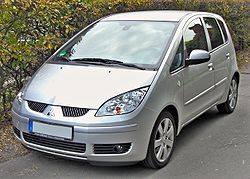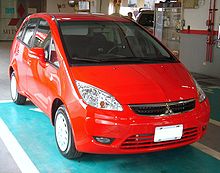- Mitsubishi Colt
-
Mitsubishi Colt 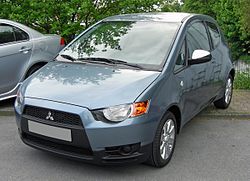
Manufacturer Mitsubishi Motors Production 1962–present The Mitsubishi Colt is a vehicle built by Mitsubishi Motors since 1962. It was first introduced as a series of kei cars and subcompact cars in the 1960s, and then as the export version of the Mitsubishi Mirage hatchback in the 1980s and 1990s. The Chrysler Corporation, Mitsubishi's longtime partner, also used the name in the 1970 when it rebadged the second generation Mitsubishi Galant as Dodge Colt and Plymouth Colt captive imports for the United States market. The most recent version is a supermini manufactured in Japan at Okazaki and in Europe at their NedCar plant in the Netherlands, using the same underpinnings as its sister car, the now discontinued Smart Forfour.
Contents
First generation (1962–71)
First generation 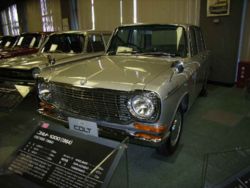
Also called Dodge Colt
Plymouth ColtProduction 1962-1971 Assembly Assembly Nagoya plant, Okazaki, Aichi, Japan Body style 3-door hatchback
4-door sedan
5-door hatchbackLayout FR layout Engine 594 cc NE35A I2 Mitsubishi introduced the "Colt" name in 1962 on the Colt 600, the first of a line of small, sporty vehicles complementing their Mitsubishi 500, the company's first post-war passenger car. Powered by a NE35A 594 cc OHV two cylinder air-cooled engine. At this time, Mitsubishi Motors did not yet exist as an autonomous company, and vehicles were being produced by three regional subsidiaries of Mitsubishi Heavy Industries. MHI, which had been formally dismantled after World War II, resumed operating as a single entity in 1964, but continued to use the 'Colt' marque until the 1970s in Asia, and the 1980s in Europe.
To complement the 600, a larger compact car was introduced in 1963, the Colt 1000, followed by the fastback Colt 800 and larger Colt 1500 in 1965, and the Colt 1100 in 1966.[1]
The Colt marque was used from 1974 by the Colt Car Company to market Mitsubishis in the United Kingdom, and phased out in 1984. In New Zealand, the Colt brand ceased in favour of the Mitsubishi name in 1970, upon the release of the new "Dyna-wedge" Galant model. Colt again surfaced as a model name for the Australian edition of the front-drive Mirage in 1979, and again for a new small car in 2003.
Second generation (1978–1983)
Second generation (Colt A150) 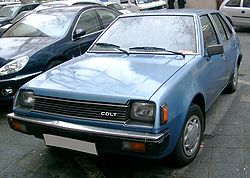
Also called Lancer Fiore
Mitsubishi Mirage
Dodge Colt
Plymouth ChampProduction 1978–83
(1982-90 in Australia)Assembly Nagoya plant, Okazaki, Aichi, Japan
Wellington, New ZealandBody style 3-door hatchback
4-door sedan
5-door hatchbackLayout FF layout Mitsubishi launched the Mirage (marketed as the Colt in many countries) as a three-door front wheel drive hatchback in 1978, as a response to the first fuel crisis some years before. It had a distinctive design with large windows and Mitsubishi's Super Shift ("Twin Stick" in the US) transmission which offered four speeds in two modes. A five-door joined the range in 1979. This car was exported to the United States as the Dodge Colt and Plymouth Champ from 1979 and received the highest United States Environmental Protection Agency fuel economy rating that year.
The Super Shift was not originally planned on. Mitsubishi's engineers had to use the existing Orion engine. Placed transversely, the carburettor faced forward and ran into icing issues. If the engine was turned around, it would have to be modified to run in the other direction. Instead a transfer gearbox was installed, the development of which cost no more than developing a new five-speed transmission.[2]
A 1,600 cc engine joined the range in 1979. In 1981, the Lancer Fiore, not to be confused with the regular Lancer, was launched. The Fiore was a four-door version of the Mirage/Colt and was sold as a Colt in Australia. At the same time, the range was facelifted.
In 1982, a turbocharged, 105 PS (77 kW) version of the 1,400 cc engine was made available.
Since most overseas markets did not have the Minica kei car, the Mirage/Colt was usually sold as Mitsubishi's entry-level model. In many countries, this car was known as the Mitsubishi Mirage. In the UK, where Colt was the marque, it was called the Colt 1200 and Colt 1400, after the size of the engines, which it shared with the larger Lancer.
Local CKD assembly of the Colt took place in New Zealand by the Todd Motor Corp., where there was a sports equivalent called the Mirage Panther in the early 1980s. The replacement Mirage Turbo had the distinction of being that country's first locally assembled turbocharged car from 1982.
The facelifted model was also built by Mitsubishi Motors Australia at their Tonsley Park plant in Adelaide from 1982[3] to 1990. It was offered with the 1.4 L and 1.6 L engines in five-door hatchback form and a Colt four-door sedan, based on the Japanese Lancer Fiore was also produced. This model was also briefly exported to New Zealand in the late 1980s, where it shared showroom space with the locally assembled third generation models.
Third generation (1983–1987)
Third generation (Colt C10) 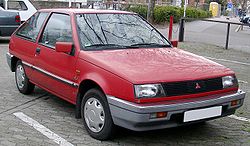
Also called Mitsubishi Lancer Production 1983–1987 Assembly Kurashiki, Okayama, Japan Body style 3-door hatchback
4-door sedan
5-door hatchback
5-door station wagonLayout Front engine, front-wheel drive/four-wheel drive Mitsubishi launched a new Colt in 1983, still splitting the range into Mirage (three- and five-door hatchback) and Lancer Fiore (four-door sedan) models, though some export markets did sell the four-door as the Mirage. A station wagon was added in 1985 and a four-wheel-drive wagon in 1986.
Engine power for the 4G32BT engine for the USDM "Turbo Sport" model, was 105 horsepower; the 3-door hatchback Turbo Sport weighted in at a low 2005 USDM pounds.
Many export markets sold the hatchbacks as the Mirage or Colt, and the sedan and station wagon as the Lancer.
A commercial version of the wagon was sold in New Zealand as the Mitsubishi Express, replacing an earlier model based on the Mitsubishi Galant Sigma.
New engines were added: the 1300 and 1500 cc engines replaced the 1200 and 1400; an 1800 cc diesel was also added.
The Colt/Mirage was not sold in the U.S. by Mitsubishi until 1985, and it was this version that made the marque's début there.
The four-door model formed the basis of the Proton Saga, Malaysia's first locally built car. Proton would spin the Saga off into a five-door hatchback (styled differently from Mitsubishi's own five-door hatch version) called the Saga Aeroback in 1987.
Versions available
The Mirage was available in Europe as the Mitsubishi Colt, and the following versions were offered:
- 1200 GL 3-door
- 1300 GL 3-door
- 1300 GL 5-door
- 1500 GLX 5-door
- 1800 GLD 5-door
The Lancer saloon was available in the same trim levels as the hatchback model, while the estate versions were available as 1500 GLX and 1800 GLD only.
Australia got only the 1300 GL and 1500 GLX versions.
The Colt sold well in Europe but in Denmark it was one of the country's top-selling cars.
Fourth generation (1987–1992)
Fourth generation (Colt C50) 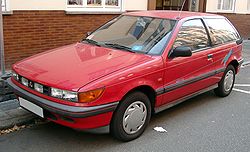
Production 1987–1992 Assembly Assembly Nagoya plant, Okazaki, Aichi, Japan
Normal, IllinoisBody style 3-door hatchback
4-door sedan
5-door hatchbackLayout FF layout Engine 1.5 L 81 hp (60 kW) I4 Transmission 3-speed automatic
4-speed manual
5-speed manualWheelbase Hatchback: 2,385 mm (93.9 in)
Sedan: 2,455 mm (96.7 in)Length Hatchback: 4,030 mm (159 in)
Sedan: 4,320 mm (170 in)Width 1,670 mm (66 in) Height Hatchback: 1,320 mm (52 in)
Sedan: 1,340 mm (53 in)Curb weight 915 kg (2,020 lb) The 1987 Colt was stylistically distinct: Mitsubishi had scored well with its revamped Galant and transferred its styling to the smaller cars. The basic model was a three-door with an upright tailgate. The top Mirages in Japan were called the Mirage Cyborg, featuring a turbocharged 1600 cc engine developing 145 PS (107 kW).
Engines available were 1.3 and 1.5 12-valve 4-cylinder engines, and 1.6 and 1.8 16-valve 4-cylinder engines. European versions were available in 1300 GL, 1500 GLX, 1600 GTi, 1800 GTi 16v versions.
Four-door models were usually called Lancer overseas, but Mirage (usually Mirage Vie Saloon) inside Japan. In Australia, all the models in this range were badged Mitsubishi Lancer.
The 1989–92 model year Colt was also sold as the Dodge/Plymouth Colt (as a hatchback) and the Eagle Summit in the U.S. In Canada, the Mirage sedan that time was known as the Dodge/Plymouth Colt, because Mitsubishis weren't sold in Canada up until the 2003 model year.
The Colt Turbo was on Car and Driver's Ten Best list for 1989.
The five-door hatchback and station wagon were carried over, though a five-door lift back was launched not long after the rest of the range on the new platform.
Face lift
The 1991 Colt three-door was more rounded and sportier than its predecessor, and the range of engines grew to include a 1600 cc 24-valve V6. The standard engine was a 1600 cc 16-valve DOHC four-cylinder unit, but a 1400 cc engine was still available. This model launched in North America for the 1993 model year.
The four-door Colt, with a six-window greenhouse and different sheet metal to the Lancer, was sold as the Eagle Summit in the US. It was generally not offered in countries other than Japan, Canada and the U.S. The Japanese models saw the Vie Saloon tag continue. (These were known as the 'CB' chassis in countries such as Australia, New Zealand and other parts of the globe.)
Fifth Generation (1991–1996)
Fifth generation (Colt CAO) 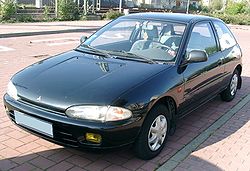
Production 1991–1996 Assembly Kurashiki, Okayama, Japan
Normal, IllinoisBody style 3-door hatchback
4-door sedan
2-door coupeLayout Front engine, front-/four-wheel drive Engine 1.5 L 92 hp (69 kW) I4
1.6 L 172 hp (128 kW) I4 (MIVEC)
1.8 L 113 hp (84 kW) I4Transmission 3-speed automatic
4-speed automatic
5-speed manualWheelbase 2,500 mm (98 in)
Coupe: 2,440 mm (96 in)Length 4,375 mm (172.2 in)
Coupe: 4,345 mm (171.1 in)Width 1,690 mm (67 in)
Coupe: 1,680 mm (66 in)Height 1,325 mm (52.2 in)
Coupe: 1,310 mm (52 in)Curb weight 946 kg (2,090 lb) In 1991, the 5th Generation or 'CC' chassis platform changed to a modern more stylish rounder shape to its predecessors. A two-door coupe was introduced based on the Colt (the Asti in Japan) and sold outside Japan to a number of countries around the world as the 'CC' chassis Colt (in New Zealand and United States), and the Lancer coupe in Australia. These deliveries mainly saw a Front wheel drive 1500 cc 8 valve SOHC caburettor engine in the base GL model, or a 1800 cc SOHC 8 valve EFI engine in the higher GLXi variant in Australia, and the same engines were offered in New Zealand and overseas but in a choice of either Front Wheel Drive or All wheel drive variant, and either a 2-door, 3-door (Cyborg) or 4-door shape. This is where the first MIVEC 1600 cc engines started to roll out in Mitsubishi platforms. The 2-door CC coupe was sold with the CA5A chassis description. Mitsubishi's engine choices were vast with this new platform. Their most popular were the 4G15 1.5 Carburetor, 4G15 1.5 fuel injected, 4G93 1.8 EFI, 4G93 1.8 DOHC EFI, 4G92 1.6 MIVEC EFI, a 4G91 1.8 DOHC caburetor, and even a 6A10 (V6)and 4D68 Turbo Diesel all in either a front wheel drive or All Wheel Drive format. The 2.0 L 4G63 turbo was an option only in the U.S., but was quickly dropped in favor of using this power option in the soon to be released Lancer Evolution I.
Proton took over the license to this design for its range from 1997 onwards and it is still offered in some countries as the Proton Satria (three-door, ex Cyborg) and Proton Wira (four and five-door), Proton M21/Putra coupe (2-door), or 200 and 400 series. Not only is the car still being built by Proton, but they also developed a pickup/ute variant of the chassis and named it the Proton Jumbuck.
Mitsubishi started manufacturing the fifth generation/CC platform in 1991, it was taken over by Proton in 1996/97 and is still being utilised in 2006.
With the split between the name Asti/Mirage/Lancer namesake spanning over several countries it created somewhat of a confusion but something that all models share is the 'CC' chassis platform. The rounder shape of the Asti/Mirage/Lancer coupe, hatch and 4 door sedan gave them a modern sportier appearance different from the squarer 'CC' chassis of the Mirage/Lancer sold alongside it in the showroom floor. These squarer 4th Generation versions of the Lancer/Mirage sedan and wagon (as pictured to the right) had the similar appearance as the popular Evolution Lancer 1-3 models which were used in rally. These models were available in sedan or wagon and either FWD or AWD. A 1800 cc DOHC Turbo 145 kW (197 PS; 194 hp) version of the Lancer Sedan was sold as the "GSR Turbo" variant in Australia and New Zealand, and the AWD turbo wagon was only available in New Zealand under the "Libero" name. These versions were based on the EVO 1-3 models, but only offered with a 1800 cc 4G93T turbo engine, not the 2000 cc 4G63T turbo engine as in the EVO models.
Sixth generation (1995–2002)
Sixth generation (Colt CJO) 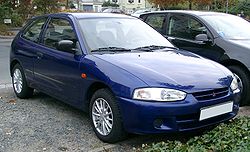
Production 1995–2002 Assembly Assembly Mizushima plant, Kurashiki, Okayama, Japan, Tambon Klong, Thailand
Normal, IllinoisBody style 3-door hatchback
4-door sedan
4-door wagon
2-door coupeLayout FF layout Engine 1.3 L 4g13 SOHC 74 hp (55 kW) I4
1.5 L 4g15 SOHC 92 hp (69 kW) I4
1.5 L 4g15 DOHC 110 hp (82 kW) I4 (JDM)
1.6 L 4g92 SOHC 89 hp (66 kW) I4
1.6 L 4g92 DOHC MIVEC 172 hp (128 kW) I4 (JDM)
1.8 L 113 hp (84 kW) I4Transmission 4-speed automatic
5-speed manualWheelbase Hatchback: 2,415 mm (95.1 in) Length Hatchback: 3,880 mm (153 in) Width Hatchback: 1,680 mm (66 in) Height Hatchback: 1,385 mm (54.5 in) Curb weight 1,045 kg (2,300 lb) A new Colt was launched in 1995 and called the 'CE', 'CJ', or 6th Generation chassis. The range was rationalized to a two-door coupe (still called Mirage Asti in Japan), three-door hatchback (Colt) and a four-door sedan, Lancer in export markets.
A station wagon on this platform was offered but never as a Mirage, in either Japan or overseas. In Japan, it had Libero badges. It is usually considered part of the Lancer lineage, not the Mirage one.
In Europe, the Colt is available in 1.3 and 1.6 L, both SOHC.
By 2003, the only Mirage sold in Japan was the coupé, without the Asti designation.
Due to Mitsubishi's financial troubles, this version of the Colt stayed in production to 2003, with minor facelifts along the way. Despite a new Lancer (the Lancer Cedia) in 2000, many countries (including Thailand and New Zealand) still sold this generation as late as 2003. The U.S., which sold the range as the Mirage from 1997–2002, replaced it with the Lancer Cedia (called plain Lancer there and in all other export markets) from 2002.
With the rising popularity of boxy compact and subcompact SUVs in Japan, the Mirage nameplate was used on a domestic market-only model called the Mirage Dingo, from 1999. The Dingo was facelifted in 2001 and cancelled in 2003.
However, New Zealand sold a very different Mirage in 2002: a rebadged, Dutch-made Mitsubishi Space Star. The vehicle was not very popular and was soon discontinued.
Most countries replaced the Mirage with the Mitsubishi Colt, sharing a platform with the Smart Forfour, in 2004.
Seventh generation (2002-present)
Seventh Generation (Colt Z30) Production 2002–present Assembly Born, Netherlands
Okazaki, Aichi, Japan
Turin, Italy (Pininfarina)
Taoyuan, TaiwanClass Supermini Body style 3-door hatchback
5-door hatchback
5-door station wagon (Plus)
2-door hardtop convertibleLayout FF layout Engine 4A90, 4A91, 4G15 & 4G18 Transmission 5-speed manual, INVECS-III CVT & INVECS-III 6-speed Wheelbase 2,500 mm (98 in) Length 3,870–3,885 mm (152–153.0 in) Width 1,680 mm (66 in) Height 1,550 mm (61 in) Related Smart Forfour Designer Olivier Boulay
Omer HalilhodžićIn 2003, a new Colt was released by Mitsubishi in Japan with a design by Olivier Boulay and built on the same platform as the Smart Forfour. A European version made at Mitsubishi's NedCar facility followed into production a year later (see below).
In 2004, the Colt was launched in Europe, with models ranging from 1.1 MPI Mivec, 1.3 MPI Mivec, 1.5 MPI Mivec and 1.5 Turbo Mivec in petrol.
The Smart Forfour also shared the '03 specification chassis, with Brabus releasing a performance version of the Forfour in '04 using the same engine as used in the '04 European cz-T, but squeezing 30 extra HP out of the same 4G15.
In November 2004, a 1.5 L D-ID direct injection turbodiesel version with turbocharger and intercooler, producing 95 PS (70 kW) was made available, with an option of the Allshift automatic manual gearbox with electric clutch and six gears.
Colt CZT
The performance specification 1.5 T was based on the 4G15 block, with a Turbo and Intercooler to aid power (147 hp @ 6000 rpm / 155 lb·ft (210 N·m) @ 3500 rpm). MIVEC variable valve timing was also used to increase the output, upping the power dramatically from the 109 hp (81 kW) 1.5 MPI. The same performance engine was also used to power the later released CZC cabrio model Colt (2005), with the more petrol-friendly 1.5 MPI available as an option.
Colt CZC
Mitsubishi released its new Colt CZC coupé cabriolet to the Geneva Motor Show in March 2005, and the car has been on sale since 2006. The car is a 2+2 with a retractable hard-top and available with the turbo engine from the European cz-T or as just a 1.5 MPI. Jointly developed by Mitsubishi and Pininfarina under Ken Okuyama, it is partly made in the Netherlands, with final assembly taking part at Pininfarina in Turin, Italy.
Colt Ralliart Version-R
Mitsubishi released a new Colt Ralliart Version-R in Japan on May 30, 2006. Its 4G15 engine, with MIVEC variable valve timing and turbocharger, produces 154 PS (113 kW; 152 hp) at 6000 rpm and 210 N·m (150 lb·ft) at 3500 rpm for manual model, 154 PS (113 kW; 152 hp) at 6000 rpm and 180 N·m (130 lb·ft) at 2500 rpm for CVT model. Other key features include a stiffer spot welded chassis, stiffer suspensions, improved exhaust system, improved steering mounting, bodykit, 240km/h scale speedometer, low profile high-grip 16 inch tires (205/45R16), and Recaro bucket seats borrowed from the Lancer Evolution VIII MR. The rear seats are molded for two passengers, as opposed to three in the rest of the range. Incidentally, this is the same engine used in the 2004 European performance specification Colt (cz-T), only running slightly increased horsepower figures (torque stayed the same). This version is also sold in Australia and New Zealand as the Colt Ralliart, without the 'Version-R' designation. The CVT version is officially sold in Singapore and Hong Kong under the same designation as Japan.
In 2008, the Version R went through a minor facelift with its engine uprated to 163 PS (120 kW; 161 hp) at 6000 rpm and 210 N·m (150 lb·ft) at 3500 rpm for the manual model, 154 PS (113 kW; 152 hp) at 6000 rpm and 180 N·m (130 lb·ft) at 2500 rpm for the CVT model. The 2008 version was fitted with lighter rims and chrome headlamps, but the sunglass holder and front Recaro seats were removed and replaced with standard sports seats in Australia and New Zealand to reflect a reduced retail price. Also in 2008, a limited version called Colt Ralliart Version-R Special was launched in Japanese market for a limited number of 300 units. The difference from the usual version is further stiffer continuous seam welded chassis and a Ralliart muffler. Another 200 units of Version-R Special were launched in 2010.
Colt Plus
In 2004, the Colt Plus was launched in Japan, and later to other international markets. This was essentially a longer version of the standard Colt with around 30 cm (12 in) more boot space compared to the regular colt. The Colt plus also features an automatic tailgate with an obstacle sensor. The Tailgate can also be opened via the remote. The Colt Plus is uses 4A91 MIVEC instead of 4G15 MIVEC.
In March 2007, Mitsubishi launched Colt Plus in Taiwan, which is similar to the version launched in Japan in 2004 but the engine is different. It's powered by a 1.6-litre SOHC 4G18 engine and it's the same engine used in the 2000 Taiwanese Lancer, running slightly increased horse power figures (112 hp @ 6000RPM / 14.9 kg-m @ 4500RPM) and it uses the INVECS-III CVT transmission in fully automatic mode. In 2008 it added a sporty version for the Taiwan market called "Colt Plus iO" which uses the INVECS-III with 6 speed Shift and changed the facelift to fit the styling in Japan.
Colt Plus Turbo
The Colt Plus Turbo has the same feature as the Colt Plus except for the difference in engine and transmission. The uses the same 4G15 engine as the '04 European cz-T with an output of 143 bhp but with 180 nm of torque. The Colt Plus Turbo also uses the Invecs III with 6 speed sport Shift.
Colt Plus Ralliart
The Colt Plus Ralliart is basically a 2006 facelifted version of the Colt Plus Turbo. The 4G15 engine has been uprated to 154 bhp to match the Colt Version R. The styling of the Colt Plus Ralliart also matches the Colt Version R with the same EVO-inspired bonnet vents and bumpers. It is also accompanied with leather seats.
Mitsubishi Colt MIEV
In 2006 Mitsubishi displayed the Colt MIEV, using a separate electric motor at each wheel.[4] Development of their MIEV technology was first announced May '06 when Mitsubishi unveiled the Colt version is a rear-wheel drive all-electric vehicle fitted Colt MIEV test-bed. With two 20 kW in-wheel motors. The Colt MIEV has a top speed of 150 km/h (93 mph) and a cruising range of 150 km (93 mi) on a single charge. Charge times have been suggested to be a quick as 10 minutes, although whether this is partial or full is undisclosed. It does however point to the usage of quick-charge batteries such as those developed by Toshiba.[citation needed]
Mitsubishi used the Colt test bed to perform on-road testing to identify and resolve any problems unique to the in-wheel motor vehicle, including any deterioration in road holding and ride comfort due to increases in unsprung weight, as well as reliability and durability issues in the in-wheel motor system and its peripheral components (suspension, wheels, tires). They simultaneously worked on developing a more powerful version of the in wheel motors for 4WD applications.[citation needed]
2008 changes
Colts built in the Netherlands received a facelift in 2008. The Japan built Colt has had the facelift in October 2009.
Colt
Powertrain choices include 1.3 L engine, INVECS-III CVT transmission, 2- or 4-wheel drive for Very (XSJH9, XSDH9), COOL Very (XSJH8, XSDH8), 1.3 RX (XSXH) models. 1.5 C (XNMH) includes 1.5 L engine, 5-speed manual transmission, 2-wheel drive.
Colt Plus
Powertrain choices include 1.5 L MIVEC engine, INVECS-III CVT transmission, 2- or 4-wheel drive for Very (LSUH1), COOL Very (LSUH2), 1.3 RX (LTPH, LSPH) models. 1.5 RX also includes 6-speed sport mode settings for the CVT transmission.
Colt Limited
Engines
Models Engine codes Net hp, torque@rpm Drive Colt (DBA-Z21A) 1.3 RX 4A90 MIVEC 92 PS (68 kW; 91 hp) at 6000rpm, 124 N·m (91 lb·ft) at 4000rpm 2WD Colt (DBA-Z22A) 1.3 RX 4A90 MIVEC 91 PS (67 kW; 90 hp) at 6000rpm, 122 N·m (90 lb·ft) at 4000rpm 4WD Colt (ABA-Z23A) 1.5C 4A91 MIVEC 105 PS (77 kW; 104 hp) at 6000rpm, 141 N·m (104 lb·ft)@4000rpm 2WD Colt (DBA-Z23W) 1.5 RX 4A91 MIVEC 105 PS (77 kW; 104 hp) at 6000rpm, 141 N·m (104 lb·ft) at 4000rpm 2WD Colt (DBA-Z24W) 1.5 RX 4A91 MIVEC 102 PS (75 kW; 101 hp) at 6000rpm, 138 N·m (102 lb·ft) at 4000rpm 4WD Colt (CBA-Z27AG) Ralliart Version-R 4G15 MIVEC 163 PS (120 kW; 161 hp) at 6000rpm, 210 N·m (150 lb·ft) at 3500rpm 2WD Colt Audio System
Mitsubishi released the Colt with a CD player with an optional 6 CD changer. Upgrading the Colt stereo is possible and the original head unit can be refitted without a radio code.
Mirages sold in the United States
- 2nd generation (1985–1988) Turbocharged variant available
- 3rd generation Mirage (1989–1992) was available as a sedan and hatchback in five different trim levels with 2 or 4 doors.
- In 1989 only, the top hatchback model carried a 135 hp (101 kW) 1.6 L I4 (4G61T) turbo engine.
- 1991 saw the 1.5 L (4G15) engine's new 3-valve heads boosting horsepower from 81 to 92 hp (60 to 69 kW), and a new GS sedan with a 123 hp (92 kW) 1.6 L DOHC engine (4G61) and exclusive 4-speed automatic transmission.
- Larger-yet-lighter 4th generation Mirage (1993–1996) was available as a 2-door coupe or 4-door sedan in S / ES / LS trims, all with curvier styling and a new multilink rear suspension, and all now sourced from Japan (instead of Japan or Illinois). Mitsubishi kept the base 92 hp (69 kW) 1.5 L 4-cylinder engine (4G15) but offered ES and LS sedans with a new 113 hp (84 kW) 1.8 L 4-cylinder (4G93).
- 1994 brought a new driver's-side airbag. The LS sedan lost its optional antilock brakes but the LS coupe gained the 1.8 L engine previously exclusive to sedans. 1994 was the last year of retail sales for Mirage sedans (they became limited to fleets) and for the Dodge / Plymouth Colt altogether, though the rare Eagle Summit lived alongside the Mirage through 1996.
- Only S and LS coupes returned for 1995, which both enjoyed the new passenger's side airbag (deleting the motorized seatbelt) and covered center console. The LS coupe finally gained 14 in (36 cm) wheels but lost access to power windows, power locks, and cruise control.
- 5th generation Mirage (1997–2002) was again available in sedan and coupe versions; the sedan slightly grew and the coupe slightly shrunk (as did the gas tank). The 1.5 and 1.8 L straight-4 engines from the last Mirage returned in DE and LS trims, respectively; the automatic transmission was now a 4-speed for both engines.
- 1998 brought a stronger starter and battery
- 1999 brought a slight restyling, plainer seat fabric, and for the LS coupe, white-faced gauges and a tachometer with either transmission (it was formerly exclusive to manual models)
- 2000 brought more standard equipment for both sedans, most notably the 1.8 L engine to the DE sedan; antilock brakes were deleted from the options list
- 2001 had the DE sedan renamed ES
- 2002 brought death to all sedans since the Lancer had already arrived, but coupes lived on for the Mirage's last year in America
- 2000 In Puerto Rico, the Mirage had extra trim levels such as the Mirage Technica, Mirage Playero, Technica Evolution V, and the Technica Evolution VI.
- 4G15 SOHC was offered in the Mirage DE, ES and Playero. The Technica, Technica Evolution V and Technica Evolution VI had the more powerful 4G93 SOHC engine.
References
- ^ Mitsubishi Colt, Mitsubishi Motors South Africa website
- ^ Yamaguchi, Jack K. (1979), Lösch, Annamaria, ed., "The Year of Uncertainty?", World Cars 1979 (Pelham, NY: The Automobile Club of Italy/Herald Books): 61-62, ISBN 0-910714-11-8
- ^ Davis, Tony (1987). Aussie Cars. Hurstville, N.S.W.: Marque Publishing. pp. 165. ISBN 0947079017.
- ^ "MIEV - Mitsubishi In wheel motor Electric Vehicle - A next-generation EV", Mitsubishi Motors website
External links
Mitsubishi Motors North America timeline Type 1980s 1990s 2000s 2010s 0 1 2 3 4 5 6 7 8 9 0 1 2 3 4 5 6 7 8 9 0 1 2 3 4 5 6 7 8 9 0 1 Subcompact Cordia Tredia Mirage Mirage Mirage Precis Compact Mirage Lancer Lancer Galant Galant Sigma Galant Diamante Sport compact Eclipse Eclipse Eclipse Eclipse Lancer Evolution Lancer Evolution Mid-size Galant Galant Diamante Diamante Sports car Starion 3000GT Station wagon Space Wagon Expo Expo LRV Compact XUV Outlander Outlander Outlander Sport/RVR Mid-size XUV Endeavor Minivan Vanwagon Sport utility vehicle Montero Sport Montero Montero Montero Pickup Mighty Max Mighty Max Raider Categories:- Mitsubishi Motors vehicles
- Euro NCAP superminis
- Cars of the Netherlands
- 1960s automobiles
- 1970s automobiles
- 1980s automobiles
- 1990s automobiles
- Subcompact cars
- Hardtop convertibles
- 2000s automobiles
- Vehicles introduced in 1978
- Front wheel drive vehicles
- All wheel drive vehicles
- Hatchbacks
- Vehicles with CVT transmission
- Rear wheel drive vehicles
Wikimedia Foundation. 2010.


